Aldehyde mechanism - Study guides, Class notes & Summaries
Looking for the best study guides, study notes and summaries about Aldehyde mechanism? On this page you'll find 156 study documents about Aldehyde mechanism.
Page 4 out of 156 results
Sort by
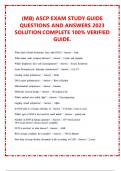
-
(MB) ASCP EXAM STUDY GUIDE QUESTIONS AND ANSWERS 2023 SOLUTION COMPLETE 100% VERIFIED GUIDE.
- Exam (elaborations) • 4 pages • 2023
-
- $15.19
- + learn more
(MB) ASCP EXAM STUDY GUIDE QUESTIONS AND ANSWERS 2023 SOLUTION COMPLETE 100% VERIFIED GUIDE. What kind of bond do histones have with DNA? - Answer - Ionic What amino acids compose histones? - Answer - Lysine and Arginine Which lymphoma has t-cell rearrangements? - Answer - Sezary Syndrome Acute Promyelocytic leukemia translocation? - Answer - t(15,17) Leading strand polymerase: - Answer - Delta DNA repair polymerase(s): - Answer - Beta or Epsilon Mitochondrial polyme...
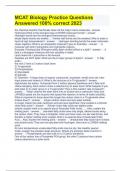
-
MCAT Biology Practice Questions Answered 100% correct 2023
- Exam (elaborations) • 23 pages • 2023
-
Available in package deal
-
- $19.99
- + learn more
MCAT Biology Practice Questions Answered 100% correct 2023 the chemical reaction that breaks down all the major macro-molecules Hydrolysis What is the strongest type of INTER-molecular bonds? Hydrogen bonds are the strongest intermolecular bonds.... diople-dipole bonds are weaker. . . Vander wall bonds are the weakest. Why is water a liquid at high temperatures? Hydrogen bonding bonds the water molocules closer together. What is an ampipathic molecule? give an Example. ...
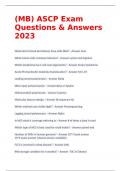
-
(MB) ASCP Exam Questions & Answers 2023
- Exam (elaborations) • 5 pages • 2023
-
Available in package deal
-
- $13.49
- + learn more
What kind of bond do histones have with DNA? - Answer Ionic What amino acids compose histones? - Answer Lysine and Arginine Which lymphoma has t-cell rearrangements? - Answer Sezary Syndrome Acute Promyelocytic leukemia translocation? - Answer t(15,17) Leading strand polymerase: - Answer Delta DNA repair polymerase(s): - Answer Beta or Epsilon Mitochondrial polymerase: - Answer Gamma Molecular beacon design: - Answer (R-sequence-Q) Which method uses visible light? - Answer Pyrosequencing Lagging...
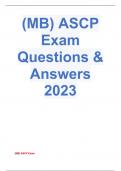
-
(MB) ASCP Exam Questions & Answers 2023
- Exam (elaborations) • 5 pages • 2023
-
Available in package deal
-
- $12.99
- + learn more
What kind of bond do histones have with DNA? - Answer Ionic What amino acids compose histones? - Answer Lysine and Arginine Which lymphoma has t-cell rearrangements? - Answer Sezary Syndrome Acute Promyelocytic leukemia translocation? - Answer t(15,17) Leading strand polymerase: - Answer Delta DNA repair polymerase(s): - Answer Beta or Epsilon Mitochondrial polymerase: - Answer Gamma Molecular beacon design: - Answer (R-sequence-Q) Which method uses visible light? - Answe...

-
FL 5 AAMC MCAT question with complete solution 2024 LATEST EDITION GUARANTEED GRADE A+
- Exam (elaborations) • 16 pages • 2024
-
- $17.99
- + learn more
What is the chemical structure of a component found in four of the five cofactors used by Na+-NQR? says it is composed of flavin structure is a nucleotide base structure B could be structure C also could be structure D is an amino acid down between B and C to help, look at the captioned note on the table. it says Fl represents flavin which is the redox active center in four of the five cofactors of Na+-NQR C has an uniquinone AND HERE IS IS MENTIONED THAT UNIQUINONE IS IS A SUBSTATE W...

-
Histology Exam 1 and Practical 1 fully solved & updated
- Exam (elaborations) • 61 pages • 2024
-
- $7.99
- + learn more
Resolution - ANSWER-Ability of a microscope to distinguish two objects as separate What do you call a measurement of 10^-6 m? - ANSWER-Micrometer, or micron Light Microscope - ANSWER-microscope that uses a beam of light passing through one or more lenses to magnify an object What resolving power does a light microscope have? - ANSWER-0.25 micrometers Types of Light microscopes (4) - ANSWER-- Simple (Dissecting) - Compound (What we use in lab to view slides regularly) - Dark Field (...
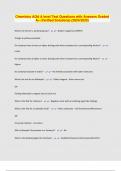
-
Chemistry AQA A level Test Questions with Answers Graded A+ (Verified Solutions) (2024/2025)
- Exam (elaborations) • 139 pages • 2024
-
- $15.48
- + learn more
Chemistry AQA A level Test Questions with Answers Graded A+ (Verified Solutions) (2024/2025) What's the Test for a Carbonyl group? - - Brady's reagent (2,4 DNPH) Orange to yellow precipitate Do Carbonyls have a lower or higher boiling point when compared to a corresponding Alcohol? - - Lower Do Carbonyls have a higher or lower boiling point when compared to a corresponding Alkane? - - Higher Do Carbonyls dissolve in water? - - Yes limited association with water molecules What's the t...
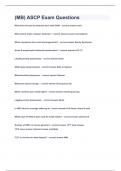
-
(MB) ASCP Exam Questions|2023 LATEST UPDATE|GUARANTEED SUCCESS
- Exam (elaborations) • 5 pages • 2023
-
Available in package deal
-
- $14.99
- + learn more
What kind of bond do histones have with DNA? Ionic What amino acids compose histones? Lysine and Arginine Which lymphoma has t-cell rearrangements? Sezary Syndrome Acute Promyelocytic leukemia translocation? t(15,17) Leading strand polymerase: Delta DNA repair polymerase(s): Beta or Epsilon Mitochondrial polymerase: Gamma Molecular beacon design: (R-sequence-Q) Which method uses visible light? Pyrosequencing Lagging strand p...
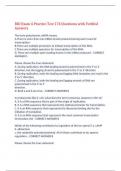
-
BIO Exam 4 Practice Test 174 Questions with Verified Answers,100% CORRECT
- Exam (elaborations) • 25 pages • 2024
-
- $12.99
- + learn more
BIO Exam 4 Practice Test 174 Questions with Verified Answers The term polycistronic mRNA means: A.There is more than one mRNA strand produced during each round of transcription. B.There are multiple promotors to initiate transcription of this RNA. C.There are multiple operators for transcription of this RNA. D. There are multiple open reading frames in the mRNA produced. - CORRECT ANSWER D Please choose the true statement: A. During replication, the DNA leading strand is polymerized i...
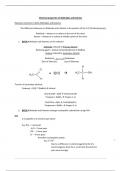
-
Chemical properties of Aldehydes and Ketones Reactions common to both Aldehydes and Ket
- Exam (elaborations) • 45 pages • 2024
-
- $17.63
- + learn more
Chemical properties of Aldehydes and Ketones Reactions common to both Aldehydes and Ketones The difference between an Aldehyde and a Ketone is the position of the C=O (Carbonyl group). Aldehyde – always on a carbon at the end of the chain Ketone – Always on a carbon at middle carbon of the chain 1. BOTH Aldehydes and Ketones can be reduced Aldehyde reduced to Primary Alcohol Reducing agent = Sodium tetrahydroborate III (NaBH4) Ketone reduced to Secondary Alcohol Reduction Oxidisatio...

That summary you just bought made someone very happy. Also get paid weekly? Sell your study resources on Stuvia! Discover all about earning on Stuvia


